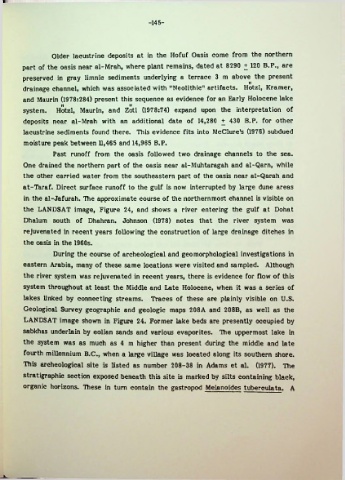Page 169 - Life & Land Use on the Bahrain Islands (Curtis E Larsen)
P. 169
-145-
Older lacustrine deposits at in the Hofuf Oasis come from the northern
part of the oasis near al-Mrah, where plant remains, dated at 8290 + 120 B.P., are
preserved in gray limnic sediments underlying a terrace 3 m above the present
drainage channel, which was associated with "Neolithic” artifacts. Hotzl, Kramer,
and Maurin (1978:284) present this sequence as evidence for an Early Holocene lake
system. Hotzl, Maurin, and Zotl (1978:74) expand upon the interpretation of
deposits near al-Mrah with an additional date of 14,280 + 430 B.P. for other
lacustrine sediments found there. TTiis evidence fits into McClure's (1976) subdued
moisture peak between 11,465 and 14,965 B.P.
Past runoff from the oasis followed two drainage channels to the sea.
One drained the northern part of the oasis near al-Muhtaragah and al-Qarn, while
the other carried water from the southeastern part of the oasis near al-Qarah and
at-Taraf. Direct surface runoff to the gulf is now interrupted by large dune areas
in the al-Jafurah. The approximate course of the northernmost channel is visible on
the LANDSAT image, Figure 24, and shows a river entering the gulf at Dohat
Dhalum south of Dhahran. Johnson (1978) notes that the river system was
rejuvenated in recent years following the construction of large drainage ditches in
the oasis in the 1960s.
During the course of archeological and geo morphological investigations in
eastern Arabia, many of these same locations were visited and sampled. Although
the river system was rejuvenated in recent years, there is evidence for flow of this
system throughout at least the Middle and Late Holocene, when it was a series of
lakes linked by connecting streams. Traces of these are plainly visible on U.S.
Geological Survey geographic and geologic maps 208A and 208B, as well as the
LANDSAT image shown in Figure 24. Former lake beds are presently occupied by
sabkhas underlain by eolian sands and various evaporites. The uppermost lake in
the system was as much as 4 m higher than present during the middle and late
fourth millennium B.C., when a large village was located along its southern shore.
Tliis archeological site is listed as number 208-38 in Adams et al. (1977). The
stratigraphic section exposed beneath this site is marked by silts containing black,
organic horizons. TTiese in turn contain the gastropod Melanoides tuberculata. A

